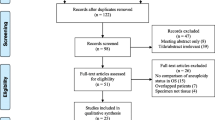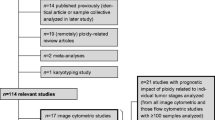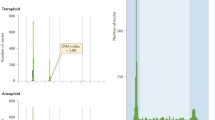Abstract
Gastric cancer is a leading cause of death worldwide. Nowadays, complete surgical resection and TNM at diagnosis are the main prognostic factors. In spite of this, many patients will have a recurrence after surgery and die within a few months or years. That means that we need more accurate prognostic factors to design specific approaches for individual patients. Chromosome instability is a feature of gastric cancer commonly associated to chromosomal aberrations that leads to major modifications of DNA content globally termed as aneuploidy. In this regard, many authors’ opinions diverge regarding the clinical impact of aneuploidy. This review will summarise data on the clinical impact of aneuploidy on clinical practice, the biological mechanisms that underlie chromosomal instability that induces aneuploidy and the relevance of specific chromosomal aneuploidy to cancer biology.
Similar content being viewed by others
References
Hohenberger P, Gretschel S (2003) Gastric cancer. Lancet 362:305–315
Correa P, Piazuelo MB, Camargo MC (2004) The future of gastric cancer prevention. Gastric Cancer 7:9–16
Correa P, Haenszel W, Cuello C et al (1975) A model for gastric cancer epidemiology. Lancet 2:58–60
Cahill DP, Lengauer C, Yu J et al (1998) Mutations of mitotic checkpoint genes in human cancers. Nature 392:300–303
Weaver BA, Cleveland DW (2006) Does aneuploidy cause cancer? Curr Opin Cell Biol 18:658–667
Yonemura Y, Ooyama S, Sugiyama K et al (1990) Retrospective analysis of the prognostic significance of DNA ploidy patterns and S-phase fraction in gastric carcinoma. Cancer Res 50:509–514
Rugge M, Sonego F, Panozzo M et al (1994) Pathology and ploidy in the prognosis of gastric cancer with no extranodal metastasis. Cancer 73:1127–1133
Sakusabe M, Kodama M, Sato Y et al (1996) Clinical significance of DNA ploidy pattern in stage III gastric cancer. World J Surg 20:27–31
Victorzon M, Lundin J, Haglund C et al (1996) A risk score for predicting outcome in patients with gastric cancer, based on stage, sialyl-Tn immunoreactivity and ploidy: a multivariate analysis. Int J Cancer 67:190–193
Victorzon M, Roberts PJ, Haglund C et al (1996) Ki-67 immunoreactivity, ploidy and S-phase fraction as prognostic factors in patients with gastric carcinoma. Oncology 53:182–191
Abad M, Ciudad J, Rincon MR et al (1998) DNA aneuploidy by flow cytometry is an independent prognostic factor in gastric cancer. Anal Cell Pathol 16:223–231
Setala LP, Nordling S, Kosma VM et al (1997) Comparison of DNA ploidy and S-phase fraction with prognostic factors in gastric cancer. Anal Quant Cytol Histol 19:524–532
Danesi DT, Spano M, Fabiano A et al (2000) Flow cytometric DNA ploidy, p53, PCNA, and c-erbB-2 protein expressions as predictors of survival in surgically resected gastric cancer patients. Cytometry 42:27–34
Ohyama S, Yonemura Y, Miyazaki I (1992) Proliferative activity and malignancy in human gastric cancers. Significance of the proliferation rate and its clinical application. Cancer 69:314–321
Lee KH, Lee JS, Lee JH et al (1999) Prognostic value of DNA flow cytometry in stomach cancer: a 5-year prospective study. Br J Cancer 79:1727–1735
Esteban F, de Vega DS, Garcia R et al (1999) DNA content by flow cytometry in gastric carcinoma: pathology, ploidy and prognosis. Hepatogastroenterology 46:2039–2043
Russo A, Bazan V, Migliavacca M et al (2001) DNA aneuploidy and high proliferative activity but not K-ras-2 mutations as independent predictors of clinical outcome in operable gastric carcinoma: results of a 5-year Gruppo Oncologico dell’Italia Meridonale (GDIM) prospective study. Cancer 92:294–302
Takeno SS, Leal MF, Lisboa LC et al (2009) Genomic alterations in diffuse-type gastric cancer as shown by high-resolution comparative genomic hybridization. Cancer Genet Cytogenet 190:1–7
Doak SH, Jenkins GJ, Parry EM et al (2003) Chromosome 4 hyperploidy represents an early genetic aberration in premalignant Barrett’s oesophagus. Gut 52:623–628
Williams L, Jenkins GJ, Doak SH et al (2005) Fluorescence in situ hybridisation analysis of chromosomal aberrations in gastric tissue: the potential involvement of Helicobacter pylori. Br J Cancer 92:1759–1766
Pihan GA, Wallace J, Zhou Y et al (2003) Centrosome abnormalities and chromosome instability occur together in pre-invasive carcinomas. Cancer Res 63:1398–1404
Nigg EA (2007) Centrosome duplication: of rules and licenses. Trends Cell Biol 17:215–221
Bischoff JR, Anderson L, Zhu Y et al (1998) A homologue of Drosophila aurora kinase is oncogenic and amplified in human colorectal cancers. EMBO J 17:3052–3065
Zhou H, Kuang J, Zhong L et al (1998) Tumour amplified kinase STK15/BTAK induces centrosome amplification, aneuploidy and transformation. Nat Genet 20:189–193
Anand S, Penrhyn-Lowe S, Venkitaraman AR (2003) AURORA-A amplification overrides the mitotic spindle assembly checkpoint, inducing resistance to Taxol. Cancer Cell 3:51–62
Azimzadeh J, Bornens M (2007) Structure and duplication of the centrosome. J Cell Sci 120:2139–2142
Jang YJ, Kim YS, Kim WH (2006) Oncogenic effect of Polo-like kinase 1 expression in human gastric carcinomas. Int J Oncol 29:589–594
Cleveland DW, Mao Y, Sullivan KF (2003) Centromeres and kinetochores: from epigenetics to mitotic checkpoint signaling. Cell 112:407–421
Abrieu A, Magnaghi-Jaulin L, Kahana JA et al (2001) Mps1 is a kinetochore-associated kinase essential for the vertebrate mitotic checkpoint. Cell 106:83–93
Li Y, Benezra R (1996) Identification of a human mitotic checkpoint gene: hsMAD2. Science 274:246–248
Taylor SS, Ha E, McKeon F (1998) The human homologue of Bub3 is required for kinetochore localization of Bub1 and a Mad3/Bub1-related protein kinase. J Cell Biol 142:1–11
Peters JM (2006) The anaphase promoting complex/cyclosome: a machine designed to destroy. Nat Rev Mol Cell Biol 7:644–656
Kops GJ, Weaver BA, Cleveland DW (2005) On the road to cancer: aneuploidy and the mitotic checkpoint. Nat Rev Cancer 5:773–785
Hanks S, Coleman K, Reid S et al (2004) Constitutional aneuploidy and cancer predisposition caused by biallelic mutations in BUB1B. Nat Genet 36:1159–1161
Matsuura S, Matsumoto Y, Morishima K et al (2006) Monoallelic BUB1B mutations and defective mitotic-spindle checkpoint in seven families with premature chromatid separation (PCS) syndrome. Am J Med Genet A 140:358–367
Bohers E, Sarafan-Vasseur N, Drouet A et al (2008) Gradual reduction of BUBR1 protein levels results in premature sister-chromatid separation then in aneuploidy. Hum Genet 124:473–478
Kim HS, Park KH, Kim SA et al (2005) Frequent mutations of human Mad2, but not Bub1, in gastric cancers cause defective mitotic spindle checkpoint. Mutat Res 578:187–201
Nakagawa H, Yokozaki H, Oue N et al (2002) No mutations of the Bub1 gene in human gastric and oral cancer cell lines. Oncol Rep 9:1229–1232
Babu JR, Jeganathan KB, Baker DJ et al (2003) Rae1 is an essential mitotic checkpoint regulator that cooperates with Bub3 to prevent chromosome missegregation. J Cell Biol 160:341–353
Dai W, Wang Q, Liu T et al (2004) Slippage of mitotic arrest and enhanced tumor development in mice with BubR1 haploinsufficiency. Cancer Res 64:440–445
Michel LS, Liberal V, Chatterjee A et al (2001) MAD2 haplo-insufficiency causes premature anaphase and chromosome instability in mammalian cells. Nature 409:355–359
Iwanaga Y, Chi YH, Miyazato A et al (2007) Heterozygous deletion of mitotic arrest-deficient protein 1 (MAD1) increases the incidence of tumors in mice. Cancer Res 67:160–166
Grabsch H, Takeno S, Parsons WJ et al (2003) Overexpression of the mitotic checkpoint genes BUB1, BUBR1, and BUB3 in gastric cancer: association with tumour cell proliferation. J Pathol 200:16–22
Cimini D, Howell B, Maddox P et al (2001) Merotelic kinetochore orientation is a major mechanism of aneuploidy in mitotic mammalian tissue cells. J Cell Biol 153:517–527
Cimini D, Wan X, Hirel CB et al (2006) Aurora kinase promotes turnover of kinetochore microtubules to reduce chromosome segregation errors. Curr Biol 16:1711–1718
Knowlton AL, Lan W, Stukenberg PT (2006) Aurora B is enriched at merotelic attachment sites, where it regulates MCAK. Curr Biol 16:1705–1710
Cimini D, Fioravanti D, Salmon ED et al (2002) Merotelic kinetochore orientation versus chromosome mono-orientation in the origin of lagging chromosomes in human primary cells. J Cell Sci 115:507–515
Kollareddy M, Dzubak P, Zheleva D et al (2008) Aurora kinases: structure, functions and their association with cancer. Biomed Pap Med Fac Univ Palacky Olomouc Czech Repub 152:27–33
Macarulla T, Ramos FJ, Tabernero J (2008) Aurora kinase family: a new target for anticancer drug. Recent Pat Anticancer Drug Discov 3:114–122
Cheung CH, Coumar MS, Hsieh HP et al (2009) Aurora kinase inhibitors in preclinical and clinical testing. Expert Opin Investig Drugs 18:379–398
Nakamura Y, Tanaka F, Haraguchi N et al (2007) Clinicopathological and biological significance of mitotic centromere-associated kinesin overexpression in human gastric cancer. Br J Cancer 97:543–549
Shimo A, Tanikawa C, Nishidate T et al (2008) Involvement of kinesin family member 2C/mitotic centromere-associated kinesin overexpression in mammary carcinogenesis. Cancer Sci 99:62–70
Sandall S, Severin F, McLeod IX et al (2006) A Bir1-Sli15 complex connects centromeres to microtubules and is required to sense kinetochore tension. Cell 127:1179–1191
Wang TT, Qian XP, Liu BR (2007) Survivin: potential role in diagnosis, prognosis and targeted therapy of gastric cancer. World J Gastroenterol 13:2784–2790
Wang Y, Zhou X, Zhu H et al (2005) Overexpression of EB1 in human esophageal squamous cell carcinoma (ESCC) may promote cellular growth by activating beta-catenin/TCF pathway. Oncogene 24:6637–6645
Nishigaki R, Osaki M, Hiratsuka M et al (2005) Proteomic identification of differentially-expressed genes in human gastric carcinomas. Proteomics 5:3205–3213
Williams L, Somasekar A, Davies DJ et al (2009) Aneuploidy involving chromosome 1 may be an early predictive marker of intestinal type gastric cancer. Mutat Res [Epub ahead of print]
Yang YC, Wang SW, Wu IC et al (2009) A tumorigenic homeobox (HOX) gene expressing human gastric cell line derived from putative gastric stem cell. Eur J Gastroenterol Hepatol [Epub ahead of print]
Liang Z, Zeng X, Gao J et al (2008) Analysis of EGFR, HER2, and TOP2A gene status and chromosomal polysomy in gastric adenocarcinoma from Chinese patients. BMC Cancer 8:363
van Dekken H, van Marion R, Vissers KJ et al (2008) Molecular dissection of the chromosome band 7q21 amplicon in gastroesophageal junction adenocarcinomas identifies cyclin-dependent kinase 6 at both genomic and protein expression levels. Genes Chromosomes Cancer 47:649–656
Calcagno DQ, Guimaraes AC, Leal MF et al (2009) MYC insertions in diffuse-type gastric adenocarcinoma. Anticancer Res 29:2479–2483
Vauhkonen H, Vauhkonen M, Sipponen P et al (2007) Oligonucleotide array comparative genomic hybridization refines the structure of 8p23.1, 17q12 and 20q13.2 amplifications in gastric carcinomas. Cytogenet Genome Res 119:39–45
Yang SH, Seo MY, Jeong HJ et al (2005) Gene copy number change events at chromosome 20 and their association with recurrence in gastric cancer patients. Clin Cancer Res 11:612–620
Author information
Authors and Affiliations
Corresponding author
Rights and permissions
About this article
Cite this article
Sánchez-Pérez, I., García Alonso, P. & Belda Iniesta, C. Clinical impact of aneuploidy on gastric cancer patients. Clin Transl Oncol 11, 493–498 (2009). https://doi.org/10.1007/s12094-009-0393-z
Received:
Accepted:
Published:
Issue Date:
DOI: https://doi.org/10.1007/s12094-009-0393-z




